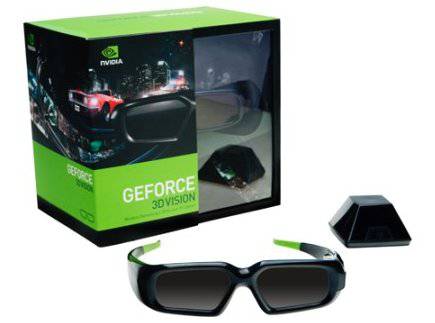- Qualcomm Launches Snapdragon 4 Gen 2 Mobile Platform
- AMD Launches Ryzen PRO 7000 Series Mobile & Desktop Platform
- Intel Launches Sleek Single-Slot Arc Pro A60 Workstation Graphics Card
- NVIDIA Announces Latest Ada Lovelace Additions: GeForce RTX 4060 Ti & RTX 4060
- Maxon Redshift With AMD Radeon GPU Rendering Support Now Available
A First Look at NVIDIA’s GeForce Vision Technology

NVIDIA’s GeForce Vision technology claims to be able to bridge the last gap between current gaming technology and the perception of an immersive 3D environment — your 2D monitor. But can it bridge the perception gap in the marketplace and overcome the view that stereoscopic 3D technologies are a cheap gimmick?
Introduction
If there’s one technology that’s come to be synonymous with PC gaming in the past decade, it’s real-time 3-D rendering. Of course, back in 1998, using the term “virtual reality” didn’t have quite the same dating effect that it does now, but the term still aptly encapsulates the objective of the majority of advancements in PC gaming.
While we’ve thankfully managed to avoid the clunky VR helmets and boxing-glove-sized handgear that leading experts back in 1992 surmised we’d be using “in the year 2000” to experience virtual 3D environments, there remains one fundamental limitation on an immersive experience of 3D gaming with today’s technology. You see, while your PC is thinking in 3D, you’re still watching the action unfold on a 2-dimensional monitor.
You have two eyes for a reason, and that reason is stereoscopic vision. Working together, your two eyes return more information to your brain than simply an object’s shape, form, texture, or color — your two eyes can also accurately locate an object’s position in space. Your brain interprets tiny differences between the view of your right eye and the view of your left eye to ascertain the position of stationary objects, and the velocity of moving objects. You can gather some positional and velocity information from the perceived change in size of an object as it nears, and from the foreshortening of objects, but the more visceral aspects of 3D perception simply can’t be reproduced by a typical PC monitor.
PC technologists weren’t the first ones to notice the lack of realism in watching a three-dimensional scene projected on a 2-D surface — the first 3-D films were shown in the 1920s. However, the technology of the day was decidedly gimmicky (think cardboard glasses with red-and-blue lenses), and degraded the quality of the viewed image in order to provide the cheap thrill of, for instance, a T. Rex reaching out of the screen to devour the moviegoing patrons seated several rows forward.
At Intel’s fall 2008 IDF conference, we were treated by Dreamworks to an unexpected opportunity to see modern cinematic 3-D technology in action, showing a version of their film Kung-Fu Panda rendered using a technique called RealD. The thick-rimmed glasses remained part of the experience, though they looked far less chintzy than their predecessors. The glasses used a pair of differently-oriented polarizing lenses that looked transparent, but transformed the blurry source frame into a sharp and astoundingly realistic 3-dimensional image, proof enough that 3-D image technology has silently been making quantum leaps while the rest of us weren’t watching.
NVIDIA GeForce Vision
Seeing the potential that this updated viewing technology held to revolutionize the way we watch movies, NVIDIA has quietly been at work on something just as novel — an algorithm to transform a 3D scene normally rasterized for a 2D display into an image that can be resolved into a 3D view using specialized eyewear.

NVIDIA’s approach uses the improved 120Hz refresh rate of the newest LCD monitors in tandem with a special type of 3D-resolving eyewear using active LCD shutter technology to display images for your right eye and left eye, rapid-fire, at viewing rates that produce seamless motion. The actual execution of this rendering technique is simple – each frame is simply rendered twice, with the camera’s location shifted a few degrees to the right or left for each eye’s view, and then the two scenes are displayed one right after the other.
At the same time that alternating frames of the stereoscopic image are being displayed, the corresponding lens of the LCD glasses becomes transparent, alternating with the other lens 120 times per second. The glasses are synchronized with the PC’s display using an IR transmitter, to ensure that the images for the left and right eyes don’t get mixed up. NVIDIA states that the glasses, which contain active electronics, are rechargeable and can be used continuously for over 40 hours on a single charge.
Now, this isn’t exactly new technology, but it’s the first time that something like this has been applied on the PC. And the glasses? They aren’t half bad, if you like the sunglasses that Rick Astley wore in the music video for “Never Gonna Give You Up”, but they could be far worse. They have the look of very thick-rimmed sunglasses with narrow lenses, but they admittedly do a better job of hiding their electronic innards than one might expect. Three interchangeable nosepieces are provided for a comfortable fit, no matter how prodigious your schnoz.
The GeForce Vision package includes a pair of the active LCD shades, an IR transmitter module with a pushbutton for enabling GeForce Vision, and cables for connnecting your PC to a HDTV for large-screen 3D viewing — the software even includes an optimized mode for LCD TVs. The glasses themselves charge via a Mini USB cable hat’s supplied with the GeForce Vision kit. The IR emitter also connects to your PC by a supplied USB cable, which could prove to be an annoyance if your USB ports are already getting fairly crowded. A curious 3-pin stereo cable is also provided to control DLP HDTVs, so if you have a DLP TV, it’ll need to be GeForce Vision compatible.
Final Thoughts
Technology to extract a three-dimensional image from a two-dimensional projection is by no means new, and it hasn’t exactly had an easy time gaining widespread acceptance. NVIDIA’s approach to rendering a stereoscopic 3D scene in real-time, however, is a fairly novel application of the existing technology. We can’t say for sure whether GeForce Vision will have much staying power as a product — the need for special glasses has often been a turn-off for entertainment consumers — but when it comes to achieving more impactful, realistic effects from 3D games, NVIDIA will have been there first.
We’ll have our own in-depth review of the GeForce Vision system ready soon, once Rob and Greg have a chance to decompress from CES, so check back in about a week to see how well GeForce Vision lives up to its hype.
Support our efforts! With ad revenue at an all-time low for written websites, we're relying more than ever on reader support to help us continue putting so much effort into this type of content. You can support us by becoming a Patron, or by using our Amazon shopping affiliate links listed through our articles. Thanks for your support!




